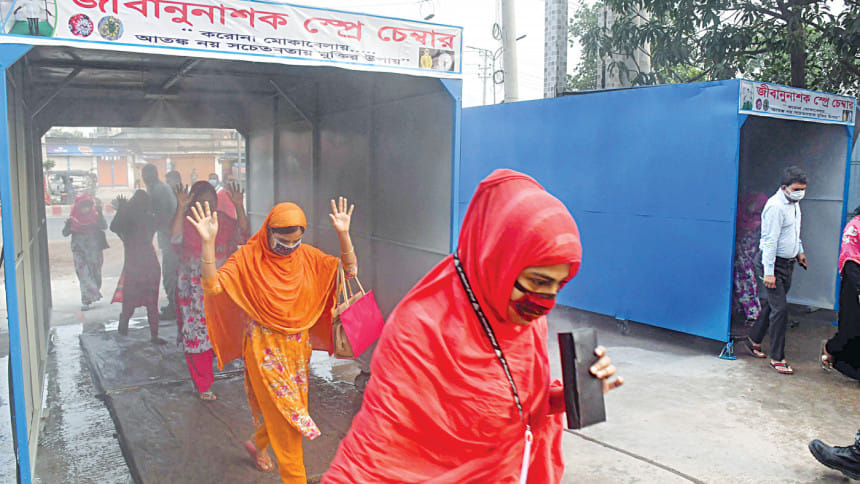RMG units reopening haphazardly

Nearly a thousand garment factories outside the capital, which resumed operation haphazardly since April 26, didn't follow the reopening schedule agreed upon at a high-profile meeting five days ago, spurring a huge influx of workers to Dhaka and elsewhere amid coronavirus risks.
The factories were supposed to reopen in phases and zone-wise in line with the schedule, prepared by Bangladesh Garment Manufacturers and Exporters Association, as decided by government high-ups, leaders of trade bodies of the garment sector, experts and economists at a meeting on April 25.
As per the decision, all the apparel factories that were closed in the second week of this month would follow the reopening schedule and ensure health safety measures for workers.
According to the BGMEA schedule, only the garment factories in Dhaka metropolitan area would reopen on April 26 and those outside in phases.
But many factories in the industrial belts in Savar, Manikganj, Narayanganj, Gazipur, Narsingdi, Mymensingh and Chattogram started resuming operation haphazardly the same day, ignoring the schedule.
Thousands of workers began pouring into these industrial belts from their village homes since April 27, raising fears of wider transmission of the deadly coronavirus. Ensuring the much-needed social distancing in the factories has now become difficult as more and more workers are joining work every day.
According to the schedule, the factories in Savar, Dhamrai and Manikganj were scheduled to reopen on April 28, 29 and 30.
The factories in Roopganj, Narsingdi and Kanchpur would resume operation on April 30, and those in Gazipur and Mymensingh on May 2 and 3, it said.
The schedule also mentioned that knitting, dyeing and sampling sections of factories would reopen between April 26 and 30, cutting section on May 2, sewing section on May 3 and finishing section on May 4.
Ahsan H Mansur, executive director of the Policy Research Institute, said the factory authorities should have waited for at least a week and utilise the time to better prepare for resuming operation.
"The decision to reopen factories came on April 25, and the factory authorities started resuming operation the following day without giving much thought," said Mansur who was present at the April 25 meeting.
The authorities should have made an announcement first and then reopen the factories gradually, he mentioned.
"The factories resumed operation without giving any notice to the workers…
"The number of coronavirus patients may increase in the worst-affected areas in Dhaka, Narayanganj and Gazipur after eight to 10 days as there is a risk of virus transmission among garment workers," he added.
Talking to this correspondent, Amirul Haque Amin, president of the National Garment Workers Federation, said the factories in the industrial belts outside the capital resumed operation in an unplanned way.
"The factory owners violated their own decision by reopening the factories haphazardly," he said.
Seeking anonymity, a top leader of the BGMEA, said, "It is true that some factories reopened without following our staggered and zone-wise approaches."
The staggered approach means opening different sections of a factory gradually. For example, the knitting section of a factory can resume operation on a specific date and the sampling section a few days later, the BGMEA leader explained, adding that
the approach was adopted to avoid influx of workers into the industrial belts.
Asked whether the BGMEA would take action against those factories, the BGMEA leader said, "We have not yet written to them about the violations...
"Six teams from BGMEA are regularly visiting factories in all the industrial zones. We found that two of the 105 factories inspected so far did not follow the BGMEA-prescribed health protocols. We asked them to improve the health safety measures.
"If any worker gets infected with the virus, the factory authorities have to look after the worker…," the BGMEA leader added.
Mohammad Hatem, vice president of Bangladesh Knitwear Manufacturers and Exporters Association, said, "We have rearranged seating plans in the factories for maintaining social distancing … We do not need any additional workers now.
"We have started operating on a limited scale. We are now running at 25 percent capacity."
He mentioned that they are running the sections, such as knitting, dyeing and sampling, which require less than 5 percent of the total workforce.
Hatem further said they arranged hand-washing facilities, disposable caps and gloves, masks and sanitisers for workers. But poor hygiene in the houses of the workers remains a major concern.
Shibnath Roy, inspector general of the Department of Inspection for Factories and Establishments, said the factory authorities may not be ensuring 100 percent compliance to the health safety measures but they are doing their best.
"Our inspectors have been regularly monitoring whether the factories are maintaining health safety standards for the workers...
The factory authorities are running their units, ensuring that one worker sits at least three feet away from another at workplaces," he added.

 For all latest news, follow The Daily Star's Google News channel.
For all latest news, follow The Daily Star's Google News channel. 



Comments